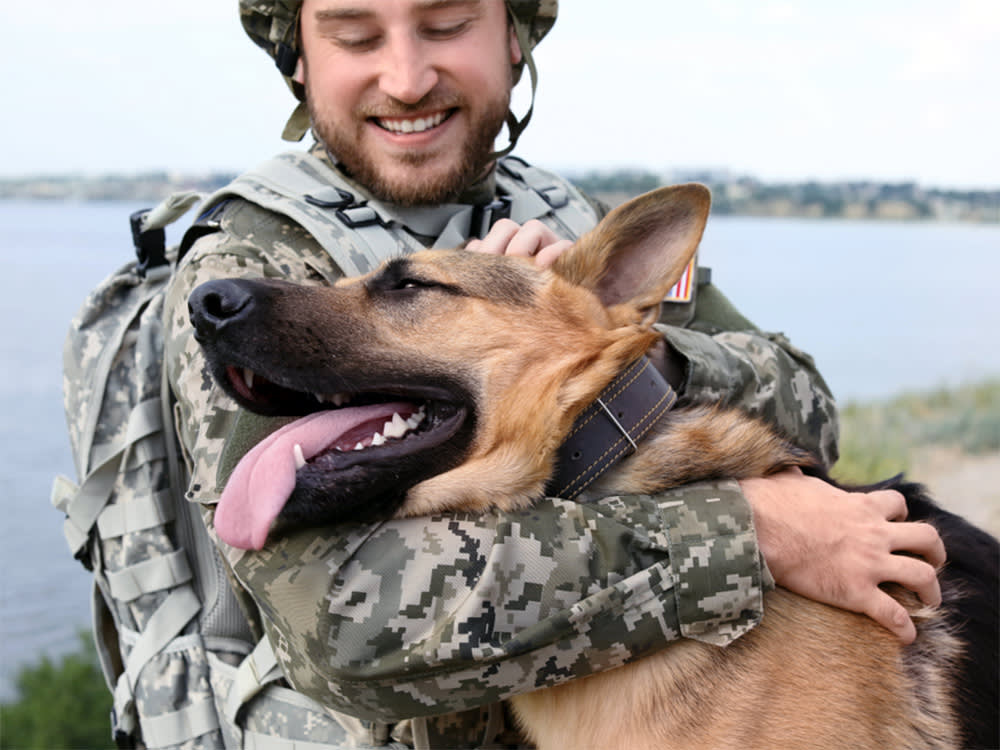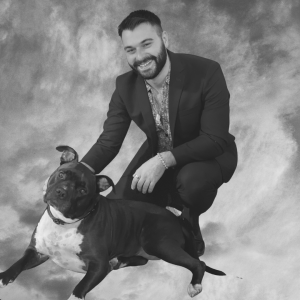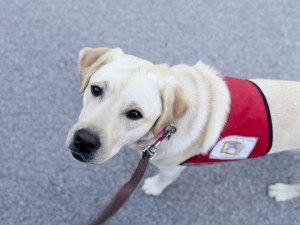This Organization Helps Veteran Dogs Find Loving Homes After Serving Our Country
“Our job is to let them relax. Let them just learn how to be a dog.”

share article

Your pet wants you to read our newsletter. (Then give them a treat.)
Since 2014, March 13 has been recognized as National K9 Veterans Dayopens in a new tab to honor every dog who has bravely served in the United States Armed Forces. Despite never enlisting, these animals have fought alongside human Americans during battles dating back to World War I.
But, not unlike other vets, their transition home is not always smooth after retiring. It’s among the plethora of reasons these forgotten heroes deserve our recognition and celebration. They also need our understanding and help.
Robby’s Law and Mission K9
The compassion for military dogs led the Clinton Administration to enact “Robby’s Lawopens in a new tab” in 2000. The legislation states that all military dogs must be made adoptable following their service with former handlers effectively having first dibs to bring them home.
“When the handler gets to adopt their dog, I can only imagine the excitement,” explains Kristen Maurer, president and co-founder ofMission K9 Rescueopens in a new tab, an organization that rescues, reunites, and rehabilitates, dogs who have served in the military. “This was their battle buddy. This was the guy that was with them in some of the most dangerous situations and he was there to protect them. I can’t imagine how they would feel. But I know that if it were me, it would just be the most important moment of my life getting that dog back.”
Prior to Robby’s Law, the circumstances surrounding military dogs following their service were frankly quite dark. These animals were viewed as military “equipment” and were routinely euthanized. But that’s not to say the bill solved all these issues, it was merely a small step in the right direction. Mission K9 Rescue was founded in 2013 to further help reunite military working dogs with their former handlers.
In fact, the organization’s chief technology officer and co-founder Bob Bryant explains that
It wasn’t until 2016 when President Obama signed a clause in the National Defense Authorization Act that military dogs who fought overseas were regularly brought back to U.S. soil, explains the organization’s chief technology officer and co-founder Bob Bryant. Of course, this clause wasn’t immune to loopholes, either. “Well, the military got around that by calling foreign operating bases U.S. soil,” Bryant says.
A history of heroes
According to the U.S. Department of Defense, there are roughly1,600 military working dogsopens in a new tab currently on active duty. The federal agency highlights a few of the most courageous trailblazing pups who have served over the past century. Despite the fact that the Army K-9 Corps was not officially established until 1942, some dogs made major contributions to the military in crucial moments well before that.
One of these pups was Stubby, a stray taken to Europe by a soldier in the 102nd Infantry Regiment during World War I. While he was initially adored simply for his ability to salute with his right paw, Stubby would go on to protect his military comrades time and again. He served in 17 battles, alerting soldiers to gas attacks and once exposing a German spy posing as a U.S. officer. As a result, Stubby became the first dog to receive a sergeant rank from the U.S. military.
Nearly 65 years later, a German Shepherd and Belgian Malinois mix named Lucca became the first dog to receive the Dickin Medal for animal valor. Lucca led around 400 patrols and identified roughly 40 explosive devices while working as a Marine Corps explosives detection dog in Iraq and Afghanistan, per the DOD. But her service came at a great cost; she had her left front leg amputated when an IED detonated nearby during a patrol. After retirement, Lucca was adopted by her former handler who saved her life that day.
A reunion to remember
Lucca’s story is emblematic of the bond these dogs share with their handlers while serving and emphasizes the importance of reuniting them after retirement. Bryant adds that it wasn’t until 2022 that the organization saw noticeable help in getting dogs home from overseas.
Before this, the cost and responsibility largely fell into the hands of handlers so Mission K9 would swoop in to ease the burden. As of 2024, the group has rescued more than a total of 1,300 dogs, reuniting over 675 dogs with their former handlers and helping rehome those without designated handlers.
She remembers one reunion between a marine named Jacob and his former war buddy, Atilla. The pair had been separated for over a year when Maurer and Mission K9 helped arrange a meet-up and adoption. As Maurer stood holding Atilla’s leash in Chicago’s Midway Airport, Jacob let out a familiar call for his old pup. She immediately heard it and went ballistic with excitement.
“That dog started dragging me across the airport so much so that I had to let go of his leash. He’s a giant German Shepherd and I was practically flying. I had to let go of the leash and he ran straight into Jacob’s arms. It was pretty incredible,” she remembers.
Maurer is happy to report that Atilla is still alive today, enjoying a peaceful retirement with her old friend. Bryant also adds that this type of reaction from dogs reuniting with their former handlers is pretty standard across the board. “It doesn’t go away. I’ve not been to one reunion or seen one instance where the dog didn’t recognize the handler. They’re a friend, a known person. You find that they’re comfortable, and the dog always remembers,” he says.
Mission K9’s ongoing work and how to help them
Many of these dogs aren’t from the U.S. Armed Forces; there is a large private sector of providers. Contrary to the K-9 Corps dogs that are well-cared for — at least while they’re still serving in the U.S. military — contract working dogs are employed by countries across the world and are subjected to varying treatment.
“We’ve seen some pretty sad situations where contract-working dogs have been killed, forgotten, or we get them back and they’re about 30 pounds underweight. It’s just sickening,” Bryant explains.
The end result is, unfortunately, similar to the challenges human veterans have. It’s not uncommon for these animals to arrive in the States with PTSD and other related behavioral issues. Of course, Mission K9 has a system in place to rehabilitate them so that they can more comfortably transition into a normal home and peaceful environment.
The organization has an extensive adoption process that has resulted in a 98 percent success rate of dogs remaining with families that adopt them. They provide dogs with any vet care they may need and never kennel them. At the Mission K9 facilities, you’ll find a series of open yards where dogs can spend all day running around in the sun before being socialized in controlled environments. It’s part of the group’s system of retraining these dogs to be pets again, or as Maurer puts it, “un-training them.”
“We call ourselves un-handlers because we’re undoing everything that the work environment did to them. Our job is to let them relax. Let them just learn how to be a dog,” she says.
One of the largest challenges Mission K9 Rescue faces is with funding. The cost of transporting dogs from other countries and providing extensive veterinary care can often venture into the thousands. If you’d like to support the group and help orchestrate military dog reunions, the org is alwaysaccepting donationsopens in a new tab.

Sean Zucker
Sean Zucker is a writer whose work has been featured in Points In Case, The Daily Drunk, Posty, and WellWell. He has an adopted Pit Bull named Banshee whose work has been featured on the kitchen floor and whose behavioral issues rival his own.
